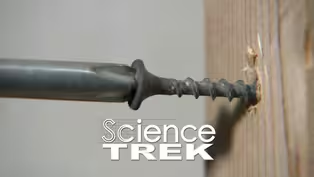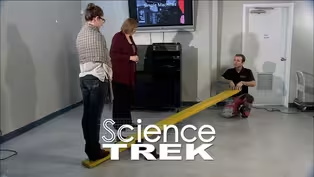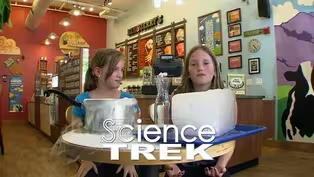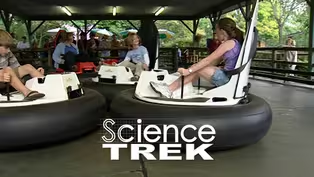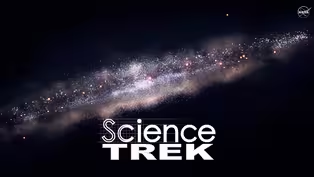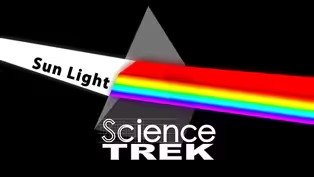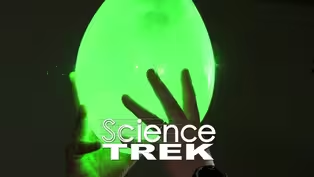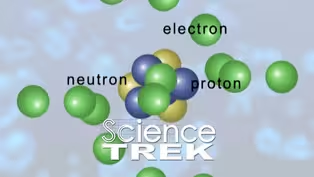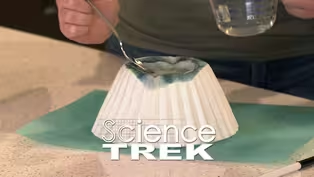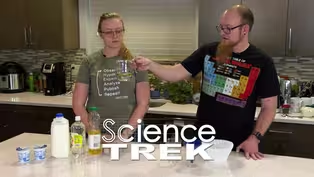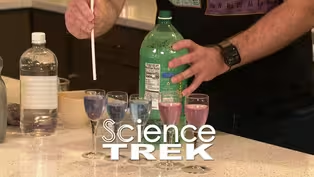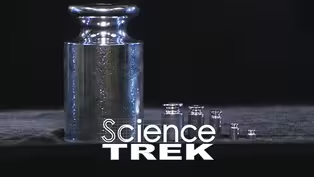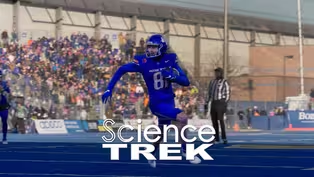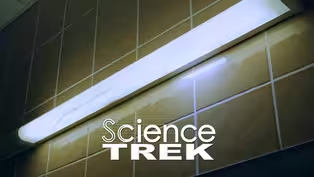
States of Matter: Rethinking Chips
Special | 5m 27sVideo has Closed Captions
How do scientists use the states of matter to create new inventions?
Scientists care about the state of matter so they can explain why things happen or how to develop new uses. Meet a material scientist and learn how he and his colleagues use the states of matter to create new semiconductors.
Problems playing video? | Closed Captioning Feedback
Problems playing video? | Closed Captioning Feedback
Science Trek is a local public television program presented by IdahoPTV
Major Funding by the Laura Moore Cunningham Foundation and the Idaho National Laboratory. Additional Funding by the Friends of Idaho Public Television and the Corporation for Public Broadcasting.

States of Matter: Rethinking Chips
Special | 5m 27sVideo has Closed Captions
Scientists care about the state of matter so they can explain why things happen or how to develop new uses. Meet a material scientist and learn how he and his colleagues use the states of matter to create new semiconductors.
Problems playing video? | Closed Captioning Feedback
How to Watch Science Trek
Science Trek is available to stream on pbs.org and the free PBS App, available on iPhone, Apple TV, Android TV, Android smartphones, Amazon Fire TV, Amazon Fire Tablet, Roku, Samsung Smart TV, and Vizio.
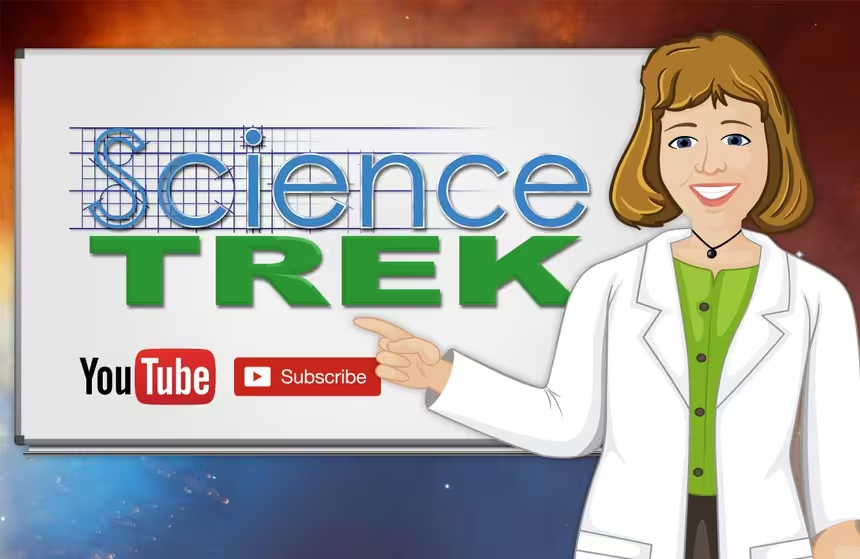
Science Trek
Science Trek is a place where parents, kids, and educators can watch short, educational videos on a variety of science topics. Every Monday Science Trek releases a new video that introduces children to math, science, technology, engineering, and math (STEM) career potentials in a fun, informative way.More from This Collection
Learning the rules is a fundamental part of playing a game. The same is true of understanding science. We need to know the basics of how things operate to begin to understand the world around us. From simple machines to states of matter, science fundamentals give us a good understanding upon which we can build. Start with the basics. Start with Science Fundamentals.
Simple Experiments with Simple Machines
Video has Closed Captions
Experiment with simple machines. (5m 32s)
States of Matter: What’s the State of Things?
Video has Closed Captions
What are the states of matter? (4m 22s)
Force and Motion: Force Makes the World Move
Video has Closed Captions
Find out more about Sir Isaac Newton’s laws of force and motion at the amusement park, Silverwood. (4m 7s)
Force and Motion: Force and Motion Rule!
Video has Closed Captions
Scientists need to understand the laws of Force and Motion to travel in space. Why? (6m 10s)
Light and Color: Hidden in Plain Light
Video has Closed Captions
Color is determined by a wavelength, your eyes, and your brain. (4m 39s)
Light and Color: Use Color to Pop a Balloon
Video has Closed Captions
Can you use a laser to pop some balloons and not others? (4m 15s)
Chemistry: Do Try This at Home
Video has Closed Captions
Learn how to test items at home to see if they are a base or an acid. (7m 16s)
Providing Support for PBS.org
Learn Moreabout PBS online sponsorshipJOAN CARTAN-HANSEN, HOST: Understanding the states of matter, how they act and react, is essential for scientists to invent or improve things.
Let's meet a materials scientist and his team who use the different states of matter to find a solution that might just impact the world.
[MUSIC] (video game sounds) STUDENT ONE: Your game system seems to be smelling funny.
STUDENT TWO: I know, something is wrong with it.
CARTAN-HANSEN: Maybe it's a problem with your chips.
STUDENT ONE: What?
CARTAN-HANSEN: The silicon chips that run your gaming console.
STUDENT TWO: What do you mean?
CARTAN-HANSEN: Well, come and see!
[Wooshing] CARTAN-HANSEN: These are silicon chips, designed with materials that work together.
They act as the brain of your gaming console.
Electricity flows through the very tiny paths called circuits.
They use a computer language to instruct the console what to do.
Dave Estrada, professor of material science engineering, studies the construction of semi-conductor chips.
DAVE ESTRADA: Your transistors can be made of different semiconductors, which those can then be wired up into other things.
You can then take all those building blocks and create large circuits.
That could be memory devices, memory chips, could be computer processing units, could be graphic processing units.
And so there you're looking at wiring together billions and billions of transistors to create one chip.
CARTAN-HANSEN: Semiconductor chips are getting so complicated that they put off a lot of heat and use a lot of energy.
And that causes problems.
ESTRADA: We have reached a fundamental limit where we put so many transistors on the existing silicon that we just can't get the heat out anymore.
And so, we're losing control of the transistors, and we just can't sustainably add more transistors onto silicon, or the chip will melt.
So, we need new materials to cut down the energy consumption at this global scale.
CARTAN-HANSEN: So, that's what he and his team are doing in the materials lab.
They're finding new materials to create new types of semiconductors.
And they do it using the different properties found in states of matter.
ESTRADA: Here at Boise State, we're using a process called metal-organic chemical vapor deposition.
And this process takes different chemicals through the various states of matter to create solid semiconductor films.
So we start with a metal containing molecule that is typically either in a liquid state of matter, or a solid state of matter, by applying heat, we can turn that into a vapor phase, carry that to the reaction chamber, where we'll mix with other gases to form molecules, which will condense on the surface and form a solid crystal.
CARTAN-HANSEN: The gases condense into films that can be patterned on the silicon chip forming circuits, kind of like dew forms on the grass.
ESTRADA: The little patterns are different transistor structures or different types of test structures.
So, we can measure the electrical properties of these films after they've been deposited.
CARTAN-HANSEN: The coating on the silicon chip is about three atoms thick.
To compare, a single stand of your hair is between half a million and a million atoms thick.
ESTRADA: We focus on making the simple, most fundamental building blocks for integrated circuits with new materials to kind of show how these materials would behave at the most fundamental level, and then can they then be applied by industry into larger integrated circuits.
CARTAN-HANSEN: Understanding how matter acts when it's in its different states- solid, liquid, gas-is key to lots of different scientific processes.
Scientists like chemists, physicists and material scientists study states of matter to explain, even to predict, how things will react to a change in temperature.
This allows scientists to create new uses, like semiconductor chips.
ESTRADA: I think the semiconductor business in general is now critical to the entire global economy because information is shared largely through the internet.
We rely on GPS and the satellites, right to kind of help navigate and transfer information around the world.
So, at the heart of all this technology, all digital technology are semiconductors, so its very critical.
[swooshing sound] STUDENTS TOGETHER: Whoa!
STUDENT ONE: That was amazing!
STUDENT TWO: Who knew states of matter could be so important?
CARTAN-HANSEN: Hey, I found out what was wrong with your game console.
You spilled some potato chips on it and a few slivers got inside and burned up.
STUDENT ONE: So, it was a problem with the chips.
[sigh] CARTAN-HANSEN: If you want to learn more about the states of matter, check out the science trek website.
You'll find it at science trek dot org.
[MUSIC] ANNOUNCER: Presentation of Science Trek on Idaho Public Television is made possible through the generous support of the Laura Moore Cunningham Foundation, committed to fulfilling the Moore and Bettis family legacy of building the great state of Idaho.
By the Idaho National Laboratory, mentoring talent and finding solutions for energy and security challenges, by the Friends of Idaho Public Television and the Corporation for Public Broadcasting.
States of Matter: Football Matter
Video has Closed Captions
Clip: Special | 1m 4s | How are football and states of matter alike? (1m 4s)
States of Matter: More on Plasma
Video has Closed Captions
Clip: Special | 1m 4s | How is plasma used on Earth? (1m 4s)
Providing Support for PBS.org
Learn Moreabout PBS online sponsorship
- Science and Nature

Explore scientific discoveries on television's most acclaimed science documentary series.

- Science and Nature

Capturing the splendor of the natural world, from the African plains to the Antarctic ice.












Support for PBS provided by:
Science Trek is a local public television program presented by IdahoPTV
Major Funding by the Laura Moore Cunningham Foundation and the Idaho National Laboratory. Additional Funding by the Friends of Idaho Public Television and the Corporation for Public Broadcasting.
